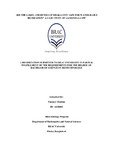| dc.contributor.advisor | Siddiqee, Mahbubul Hasan | |
| dc.contributor.author | Chakma, Tanmoy | |
| dc.date.accessioned | 2019-05-16T04:45:09Z | |
| dc.date.available | 2019-05-16T04:45:09Z | |
| dc.date.copyright | 2018 | |
| dc.date.issued | 2018-11 | |
| dc.identifier.other | ID 14236002 | |
| dc.identifier.uri | http://hdl.handle.net/10361/12065 | |
| dc.description | This thesis is submitted in partial fulfillment of the requirements for the degree of Bachelor of Science in Biotechnology, 2018. | en_US |
| dc.description | Cataloged from PDF version of thesis. | |
| dc.description | Includes bibliographical references (page 35-39). | |
| dc.description.abstract | Over the past years, surface water bodies have been contaminated due to unplanned urbanization, industrialization and defective sewerage systems. As these water bodies are a major part of diurnal and recreational activities, contamination may possess a huge health risk. The aim of this particular case study is to observe the presence and responses of Salmonella spp. in such water bodies contaminated with industrial and household pollutants. In this study, two of the most significant water bodies of Dhaka city (Hatirjheel Lake and Buriganga River) were chosen. A total of 80 water samples were collected; 40 from Hatirjheel Lake and 40 from Buriganga River respectively. Samples were collected from the month of November to February. Membrane filtration method was used to process the samples, then isolates were enriched and cultured in suitable selective media. A total of 63 presumptively Salmonella isolates was isolated from the 80 samples. The cultured isolates were then identified using molecular methods in which Salmonella specific virulence gene invA was targeted. 27 out of 30 isolates were invA positive for Hatirjheel and 20 out of 33 were invA positive for Buriganga. Following identification, antibiotic susceptibility test of the identified isolates was done using an array of 8 antibiotics of different classes. All the isolates of both Buriganga and Hatirjheel Lake were completely resistant to amoxicillin, 90% of the Buriganga isolates were resistant to cefepime while 80% of the Hatirjheel isolates were resistant to cefepime. Isolates of both water bodies were completely sensitive to Amikacin with a few intermediate sensitive seen against Norfloxacin and Gentamycin. Survival assay of the isolates resistant to most antibiotics was conducted for a period of 7 days. The survival patterns between the lake and river showed slight difference but both showed a gradual decrease in culturable count over the time. Finally, static biofilm formation was observed. Isolates from both sources form biofilm in adverse condition but biofilm formed by Buriganga river isolates at raw concentration remain more viable over time. At lower concentration (1:200) Hatirjheel isolates biofilm remain more viable. The study reveals that both Buriganga River and Hatirjheel Lake can be endemically contaminated with potentially pathogenic Salmonella and that there is an indication that the pollution level might have some influence on biofilm formation, survival rate and antibiotic resistance of Salmonella. | en_US |
| dc.description.statementofresponsibility | Tanmoy Chakma | |
| dc.format.extent | 48 pages | |
| dc.language.iso | en | en_US |
| dc.publisher | Brac University | en_US |
| dc.rights | Brac University theses are protected by copyright. They may be viewed from this source for any purpose, but reproduction or distribution in any format is prohibited without written permission. | |
| dc.subject | Antibiotic resistance | |
| dc.subject.lcsh | Biofilms. | |
| dc.title | Are the lakes and rivers of Dhaka city safe for water-based recreation? A case study of Salmonella spp. | en_US |
| dc.type | Thesis | en_US |
| dc.contributor.department | Department of Mathematics and Natural Sciences, Brac University | |
| dc.description.degree | B. Biotechnology | |

